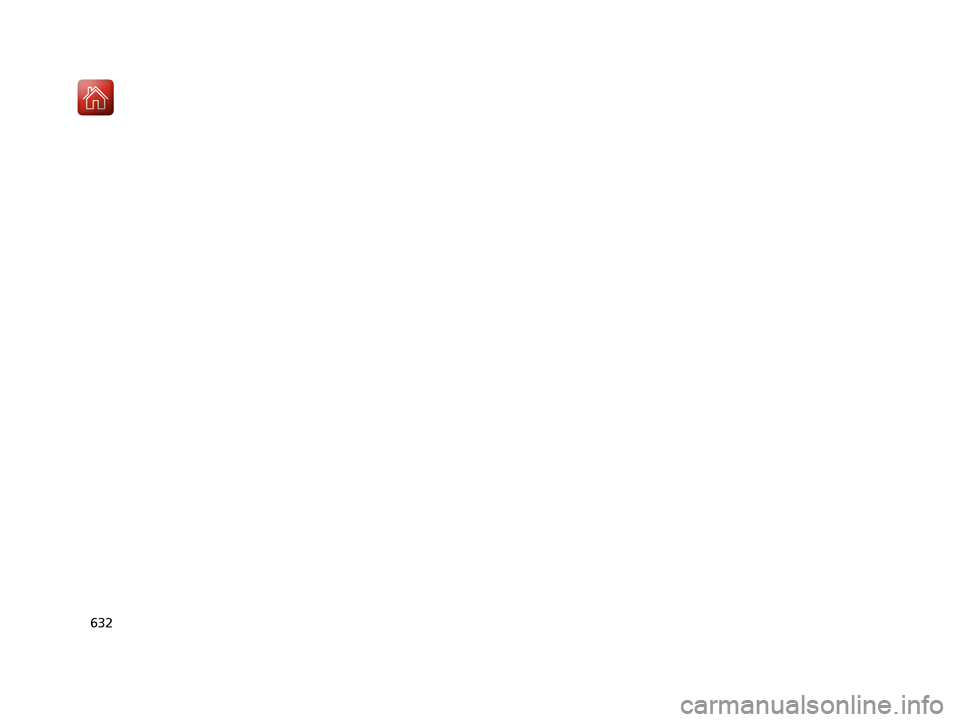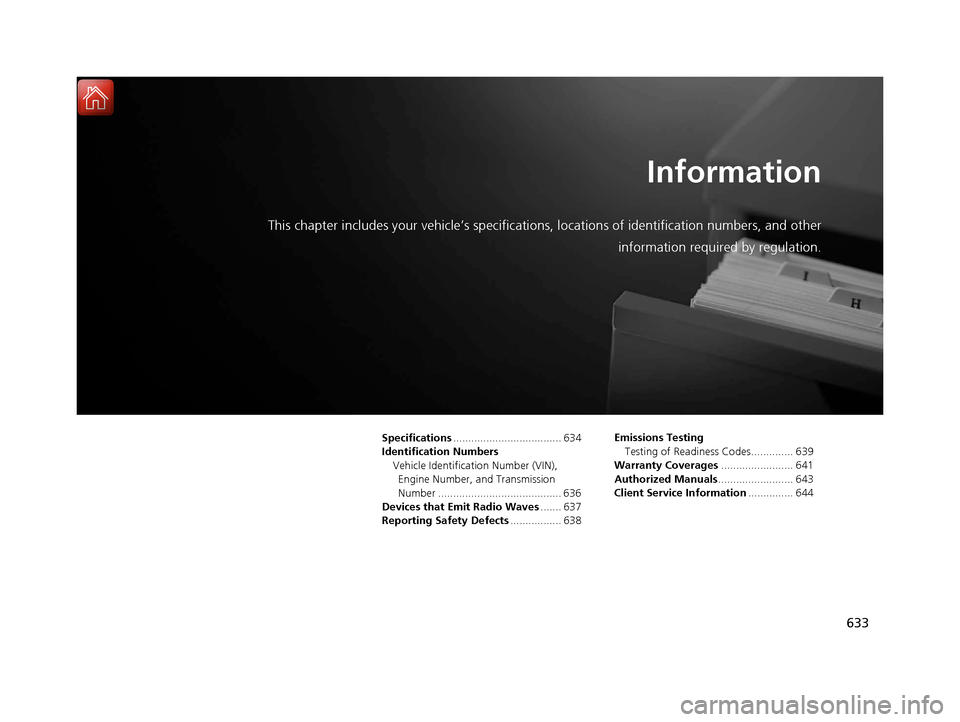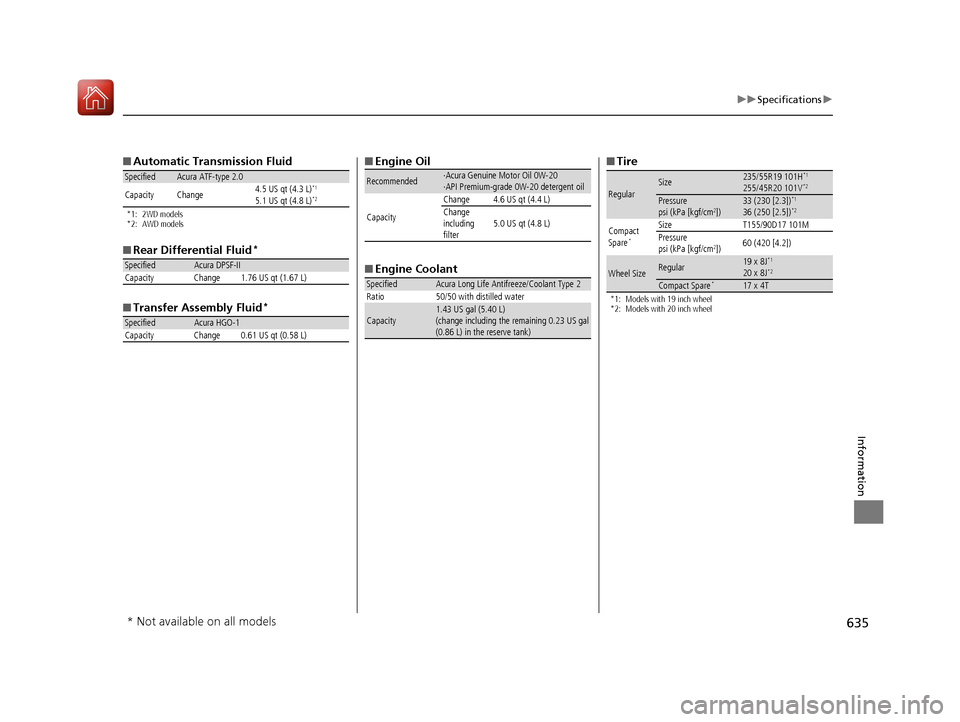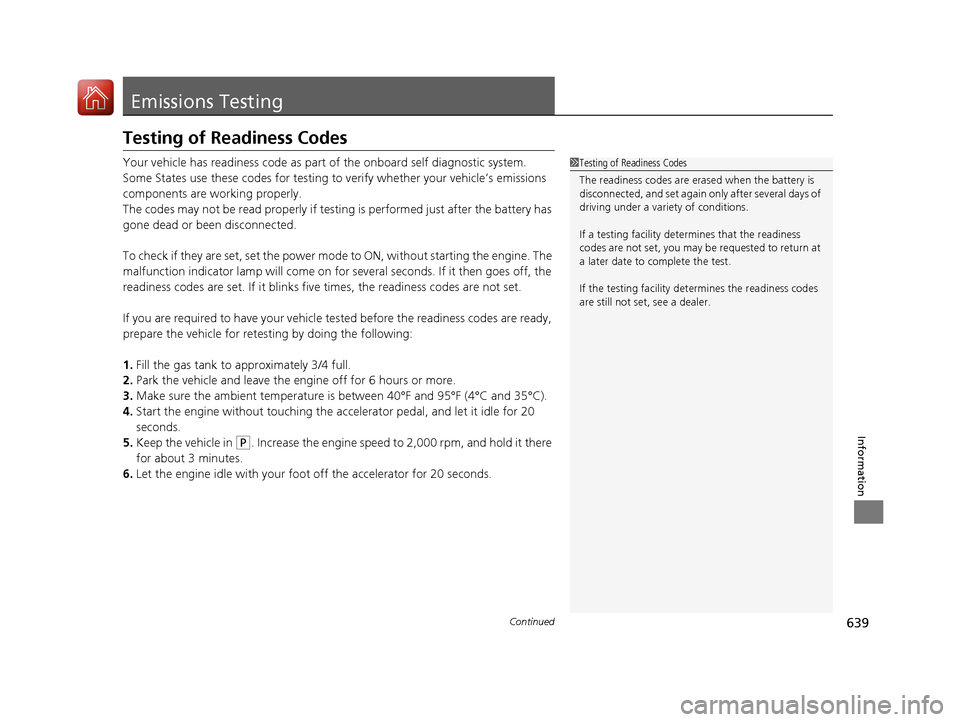R p Acura RDX 2020 Owner's Manual
[x] Cancel search | Manufacturer: ACURA, Model Year: 2020, Model line: RDX, Model: Acura RDX 2020Pages: 657, PDF Size: 33.2 MB
Page 631 of 657

630
Handling the Unexpected
When You Cannot Open the Tailgate
If you cannot open the tailgate, use the following procedure.1.Use a flat-tip screwdriver and remove the
cover on the inside of the tailgate.
u Wrap the flat-tip screwdriver with a cloth
to prevent scratches.
2. To open the tailgat e, push the tailgate
while sliding the le ver to the right.
■What to Do When Unable to Open the Tailgate1What to Do When Unable to Open the Tailgate
Following up:
After taking these steps, cont act a dealer to have the
vehicle checked.
When you open the tailgate from inside, make sure
there is enough space around the tailgate, and it
does not hit anyone or any object.
Cover
Lever
20 ACURA RDX-31TJB6111.book 630 ページ 2020年2月11日 火曜日 午後2時6分
Page 632 of 657

631
Handling the Unexpected
Refueling
Refueling From a Portable Fuel Container
If you have run out of fuel and need to refuel your vehicle from a portable fuel
container, use the funnel provided with your vehicle.
1.Turn off the engine.
2. Press on the edge of the fuel fill door to
make it pop up slightly.
u The fuel fill door opens.
3. Take the funnel out of tool box in the cargo
area.
2 Types of Tools P. 584
4.Place the end of the funnel on the lower
part of filler opening, then insert it slowly
and fully.
u Make sure that the end of the funnel
goes down along with the filler pipe.
5. Fill the tank with fuel from the portable fuel
container.
u Pour fuel carefully so you do not spill any.
6. Remove the funnel from the filler neck.
u Wipe up any fuel from the funnel before
storing it.
7. Shut the fuel fill door by hand.
1Refueling From a Portable Fuel Container
NOTICE
Do not insert the nozzle of a portable fuel container
or any funnel other than the one provided with your
vehicle. Doing so can damage the fuel system.
Do not try to pry open or push open the sealed fuel
tank with foreign objects. This can damage the fuel
system and its seal.
Make sure the fuel in the portable fuel container is
gasoline before you refuel.
3WARNING
Gasoline is highly flammable and explosive.
You can be burned or seriously injured
when handling fuel.
• Stop the engine, and keep heat, sparks,
and flame away.
• Handle fuel only outdoors.
• Wipe up spills immediately.Funnel
20 ACURA RDX-31TJB6111.book 631 ページ 2020年2月11日 火曜日 午後2時6分
Page 633 of 657

632
20 ACURA RDX-31TJB6111.book 632 ページ 2020年2月11日 火曜日 午後2時6分
Page 634 of 657

633
Information
This chapter includes your vehicle’s specifications, locations of identification numbers, and other
information required by regulation.
Specifications .................................... 634
Identification Numbers Vehicle Identification Number (VIN), Engine Number, and Transmission
Number ......................................... 636
Devices that Emit Radio Waves ....... 637
Reporting Safety Defects ................. 638Emissions Testing
Testing of Readiness Codes.............. 639
Warranty Coverages ........................ 641
Authorized Manuals ......................... 643
Client Service Information ............... 644
20 ACURA RDX-31TJB6111.book 633 ページ 2020年2月11日 火曜日 午後2時6分
Page 635 of 657

634
Information
Specifications
■Vehicle Specifications
■ Air Conditioning
ModelRDX
No. of Passengers:
Front 2
Rear 3
Total 5
Weights:Gross Vehicle
Weight RatingSee the certification label on the driver’s
doorjamb
Gross Axle Weight
Rating (Front)See the certification label on the driver’s
doorjamb
Gross Axle Weight
Rating (Rear)See the certification label on the driver’s
doorjamb
Gross Combined
Weight Rating U.S.: 5,975 lbs (2,710 kg)
Canada: 2,710 kg
Refrigerant TypeHFO-1234yf (R-1234yf)Charge Quantity17.8 – 19.6 oz (505 – 555 g)Lubricant TypeND-OIL14 (POE)Quantity4.3 – 5.2 cu-in (70 – 85 cc)
■
Engine Specifications
■ Fuel
■ Washer Fluid
Displacement121.76 cu-in (1,996 cm3)
Spark Plugs NGK DILKAR8P8SY
TypeUnleaded premium gasoline, Pump octane
number of 91 or higher
Fuel Tank Capacity 17.1 US gal (64.7 L)
Tank CapacityU.S.: 2.6 US qt (2.5 L)
Canada: 5.8 US qt (5.5 L)
■ Light Bulbs
■ Brake Fluid
Headlights (High Beam)LED
Headlights (Low Beam) LED
Fog Lights*LED
Parking/Daytime Running Lights LED
Front Turn Signal LightsLED
Side Turn Signal Lights
(on Door Mirrors) LED
Front Side Marker LightsLED
Brake Lights LED
Rear Side Marker LightsLED
Brake Lights/Taillights LED
TaillightsLED
Back-Up Lights LED
Rear Turn Signal Lights21 W (Amber/Silver)
High-Mount Brake Light LED
Rear License Plate LightLED
Puddle Lights*LEDInterior LightsMap LightsLEDAmbient LightsLEDVanity Mirror Lights1.4 WDoor Courtesy Lights3.4 WGlove Box Light1.4 WCargo Area LightLEDDoor Inner Handle LightsLED
SpecifiedAcura Heavy Duty Brake Fluid DOT 3
* Not available on all models
20 ACURA RDX-31TJB6111.book 634 ページ 2020年2月11日 火曜日 午後2時6分
Page 636 of 657

635
uuSpecifications u
Information
■Automatic Transmission Fluid
*1: 2WD models
*2: AWD models
■Rear Differential Fluid*
■Transfer Assembly Fluid*
SpecifiedAcura ATF-type 2.0
Capacity Change 4.5 US qt (4.3 L)*1
5.1 US qt (4.8 L)*2
SpecifiedAcura DPSF-II
Capacity Change 1.76 US qt (1.67 L)
SpecifiedAcura HGO-1
Capacity Change 0.61 US qt (0.58 L)
■ Engine Oil
■ Engine Coolant
Recommended·Acura Genuine Motor Oil 0W-20
·API Premium-grade 0W-20 detergent oil
Capacity Change 4.6 US qt (4.4 L)
Change
including
filter
5.0 US qt (4.8 L)
SpecifiedAcura Long Life Antifreeze/Coolant Type 2
Ratio 50/50 with distilled water
Capacity1.43 US gal (5.40 L)
(change including the remaining 0.23 US gal
(0.86 L) in the reserve tank)
■ Tire
*1: Models with 19 inch wheel
*2: Models with 20 inch wheel
RegularSize235/55R19 101H*1
255/45R20 101V*2
Pressure
psi (kPa [kgf/cm2])33 (230 [2.3])*1
36 (250 [2.5])*2
Compact
Spare*
Size T155/90D17 101M
Pressure
psi (kPa [kgf/cm
2]) 60 (420 [4.2])
Wheel SizeRegular19 x 8J*1
20 x 8J*2
Compact Spare*17 x 4T
* Not available on all models
20 ACURA RDX-31TJB6111.book 635 ページ 2020年2月11日 火曜日 午後2時6分
Page 637 of 657

636
Information
Identification Numbers
Vehicle Identification Number (VIN), Engine Number,
and Transmission Number
Your vehicle has a 17-digit vehicle identifi cation number (VIN) used to register your
vehicle for warranty purposes, and for licensing and insuring your vehicle.
The locations of your vehicle’s VIN, engine number, and transmission number are
shown as follows.
1 Vehicle Identification Number (VIN), Engine Number, and
Transmission Number
The interior vehicle identification number (VIN) is
located under the cover.
Cover
Vehicle Identification Number
Engine Number
Certification Label/
Vehicle Identification Number
Automatic Transmission
Number
20 ACURA RDX-31TJB6111.book 636 ページ 2020年2月11日 火曜日 午後2時6分
Page 638 of 657

637
Information
Devices that Emit Radio Waves
Each radio frequency device installed in the vehicle conforms to the requirements
and standards of the regulation listed below:
As required by the FCC:
This device complies with Part 15 of the FCC rules. Operation is
subject to the following two cond itions: (1) This device may not
cause harmful interferenc e, and (2) this device must accept any
interference received, including interference that may cause
undesired operation.
Changes or modifications not ex pressly approved by the party
responsible for compliance could void the user’s authority to
operate the equipment.
This device complies with Industry Canada licence-exempt RSS standard(s).
Operation is subject to the following two conditions: (1) this device may not cause
interference, and (2) this device must accept any interference, including interference
that may cause undesired operation of the device.
20 ACURA RDX-31TJB6111.book 637 ページ 2020年2月11日 火曜日 午後2時6分
Page 639 of 657

638
Information
Reporting Safety Defects
In the U.S.
If you believe that your vehicle has a defect which could cause a crash or could cause injury or death, you
should immediately inform the Nati onal Highway Traffic Safety Administration (NHTSA) in addition to
notifying American Honda Motor Co., Inc.
If NHTSA receives similar complaints, it may open an inve stigation, and if it finds that a safety defect exists
in a group of vehicles, it may order a recall and remedy campaign. However, NHTSA cannot become involved
in individual problems between you, your dealer, or American Honda Motor Co., Inc.
To contact NHTSA, you may call the Vehicle Safety Ho tline toll-free at 1-888-327-4236 (TTY: 1-800-424-
9153); go to http://www.safercar.gov ; or write to: Administrator, NHTSA , 1200 New Jersey Avenue, SE.,
Washington, DC 20590. You can also obtain othe r information about motor vehicle safety from http://
www.safercar.gov .
In Canada
If you believe that your vehicle has a defect which c ould cause a crash or could cause injury or death, you
should immediately inform Honda Canada Inc. and you may also inform Transport Canada.
If Transport Canada receives similar complaints, it may open an investigation, and if it finds that a safety
defect exists in a group of vehicles, it may lead to a recall and remedy campaign. However, Transport Canada
cannot become involved in individual problems between you, your dealer, or Honda Canada Inc.
To contact Transport Canada’s Defect Investigations and Recalls Division, you may call 1-800-333-0510. For
more information on reporting safety defects or about motor vehicle safety, go to http://www.tc.gc.ca/
roadsafety .
20 ACURA RDX-31TJB6111.book 638 ページ 2020年2月11日 火曜日 午後2時6分
Page 640 of 657

639Continued
Information
Emissions Testing
Testing of Readiness Codes
Your vehicle has readiness code as part of the onboard self diagnostic system.
Some States use these codes for testing to verify whether your vehicle’s emissions
components are working properly.
The codes may not be read properly if testing is performed just after the battery has
gone dead or been disconnected.
To check if they are set, set the power m ode to ON, without starting the engine. The
malfunction indicator lamp will come on for several seconds. If it then goes off, the
readiness codes are set. If it blinks fi ve times, the readiness codes are not set.
If you are required to have your vehicle te sted before the readiness codes are ready,
prepare the vehicle for retest ing by doing the following:
1. Fill the gas tank to approximately 3/4 full.
2. Park the vehicle and leave the engine off for 6 hours or more.
3. Make sure the ambient temperature is between 40°F and 95°F (4°C and 35°C).
4. Start the engine without touching the ac celerator pedal, and let it idle for 20
seconds.
5. Keep the vehicle in
(P. Increase the engine speed to 2,000 rpm, and hold it there
for about 3 minutes.
6. Let the engine idle with your foot off the accelerator for 20 seconds.
1Testing of Readiness Codes
The readiness codes are erased when the battery is
disconnected, and set again onl y after several days of
driving under a variety of conditions.
If a testing facility determines that the readiness
codes are not set, you may be requested to return at
a later date to complete the test.
If the testing facility determines the readiness codes
are still not set, see a dealer.
20 ACURA RDX-31TJB6111.book 639 ページ 2020年2月11日 火曜日 午後2時6分